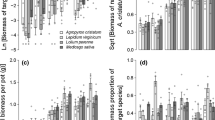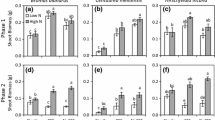Abstract
Previous research suggests that atmospheric nitrogen (N) deposition may facilitate the invasion and persistence of exotic plant species in serpentine grasslands, but the relative impact of increased N availability on native and exotic competitive dynamics has yet to be clearly elucidated. In this study, we evaluated how increased N deposition affects plant performance and competitive dynamics of five native grasses and forbs (Plantago erecta, Layia gaillardioides, Lasthenia californica, Vulpia microstachys, and Cryptantha flaccida) and the most common invasive grass in Bay Area serpentine grasslands, Lolium multiflorum. Using a growth chamber system, we exposed Lolium in monoculture, and native species grown both in monoculture and in competition with the exotic Lolium, to all four possible combinations of gaseous nitrogen dioxide (NO2; a dominant atmospheric N pollutant) and soil ammonium nitrate (NH4NO3). In monocultures, gaseous NO2 and soil N addition each increased shoot biomass in Lolium and the natives Layia and Cryptantha. Lolium competitive ability (mean relative yield potential—RYP) increased in response to NO2 addition plus soil N addition against all native competitors. Lolium and most native species did not show differences in photosynthetic rate and stomatal conductance in response to N addition. Our findings indicate that increasing N deposition and subsequent N accumulation in the soil may confer a competitive advantage to the exotic Lolium over native species by stimulating greater biomass accumulation and N allocation to photosynthetic tissue in the invader.




Similar content being viewed by others
References
Abraham JK, Corbin JD, D’Antonio CM (2009) California native and exotic perennial grasses differ in their response to soil nitrogen, exotic annual grass density, and order of emergence. Plant Ecol 201:445–456
Alexander EB, Coleman RG, Keeler-Wolf T, Harrison S (2007) Serpentine geoecology of western North America: geology, soils, and vegetation. Oxford University Press, New York
Blumenthal DM, Jordan NR, Svenson EL (2005) Effects of prairie restoration on weed invasions. Agr Ecosyt Environ 107:221–230
Bobbink R, Hornung M, Roelofs JGM (1998) The effects of air-borne nitrogen pollutants on species diversity in natural and semi-natural European vegetation. J Ecol 86:717–738
Bobbink R, Hicks K, Galloway J, Spranger T, Alkemade R, Ashmore M, Bustamante M, Cinderby S, Davidson E, Dentener F, Emmett B, Erisman JW, Fenn M, Gilliam F, Nordin A, Pardo L, De Vries W (2010) Global assessment of nitrogen deposition effects on terrestrial plant diversity: a synthesis. Ecol Appl 20:30–59
Burke MJW, Grime JP (1996) An experimental study of plant community invasibility. Ecology 77:776–790
Clark CM, Tilman D (2008) Loss of plant species after chronic low-level nitrogen deposition to prairie grasslands. Nature 451:712–715
Cleland EE, Harpole WS (2010) Nitrogen enrichment and plant communities. Ann N Y Acad Sci 1195:46–61
Corbin JD, D’Antonio CM (2004) Competition between native perennial and exotic annual grasses: implications for an historical invasion. Ecology 85:1273–1283
Corbin JD, Dyer AR, Seabloom EW (2007) Competitive interactions. In: Stromberg MR, Corbin JD (eds) California grasslands: ecology and management. University of California Press, Berkeley, pp 156–168
D’Antonio CM, Vitousek PM (1992) Biological invasions by exotic grasses, the grass fire cycle, and global change. Annu Rev Ecol Syst 23:63–87
Davidson AM, Jennions M, Nicotra AB (2011) Do invasive species show higher phenotypic plasticity than native species and, if so, is it adaptive? A meta-analysis. Ecol Lett 14:419–431
Davis MA, Pelsor M (2001) Experimental support for a resource-based mechanistic model of invasibility. Ecol Lett 4:421–428
DiTomaso JM, Healy EA (2006) Weeds of California and other western states. University of California, DANR, Davis, CA
Dukes JS, Mooney HA (1999) Does global change increase the success of biological invaders? Trends Ecol Evol 14:135–139
Evens J, San S (2004) Vegetation associations of a serpentine area: Coyote Ridge, Santa Clara County, California. California Native Plant Society, Sacramento, CA
Fenn ME, Haeuber R, Tonnesen GS, Baron JS, Grossman-Clarke S, Hope D, Jaffe DA, Copeland S, Geiser L, Rueth HM, Sickman JO (2003) Nitrogen emissions, deposition, and monitoring in the western United States. Bioscience 53:391–403
Fenn ME, Allen EB, Weiss SB, Jovan S, Geiser LH, Tonnesen GS, Johnson RF, Rao LE, Gimeno BS, Yuan F, Meixner T, Bytnerowicz A (2010) Nitrogen critical loads and management alternatives for N-impacted ecosystems in California. J Environ Manage 91:2404–2423
Funk JL, Vitousek PM (2007) Resource-use efficiency and plant invasion in low-resource systems. Nature 446:1079–1081
Galloway JN, Dentener FJ, Capone DG, Boyer EW, Howarth RW, Seitzinger SP, Asner GP, Cleveland CC, Green PA, Holland EA, Karl DM, Michaels AF, Porter JH, Townsend AR, Vorosmarty CJ (2004) Nitrogen cycles: past, present, and future. Biogeochemistry 70:153–226
Grime JP (1973) Competitive exclusion in herbaceous vegetation. Nature 242:344–347
Gruber N, Galloway JN (2008) An Earth-system perspective of the global nitrogen cycle. Nature 451:293–296
Harrison SP, Viers JH (2007) Serpentine grasslands. In: Stromberg MR, Corbin JD, D’Antonio CM (eds) California grasslands: ecology and management. University of California Press, Berkeley, pp 145–155
Harrison S, Rice K, Maron J (2001) Habitat patchiness promotes invasion by alien grasses on serpentine soil. Biol Conserv 100:45–53
Hautier Y, Niklaus PA, Hector A (2009) Competition for light causes plant biodiversity loss after eutrophication. Science 324:636–638
Hobbs RJ, Yates S, Mooney HA (2007) Long-term data reveal complex dynamics in grassland in relation to climate and disturbance. Ecol Monogr 77:545–568
Huenneke LF, Hamburg SP, Koide R, Mooney HA, Vitousek PM (1990) Effects of soil resources on plant invasion and community structure in Californian serpentine grassland. Ecology 71:478–491
Hull JC, Mooney HA (1990) Effects of nitrogen on photosynthesis and growth rates of four California annual grasses. Acta Oecol 11:453–468
Kolb A, Alpert P, Enters D, Holzapfel C (2002) Patterns of invasion within a grassland community. J Ecol 90:871–881
Lowe PN, Lauenroth WK, Burke IC (2002) Effects of nitrogen availability on the growth of native grasses exotic weeds. J Range Manage 55:94–98
Lowe PN, Lauenroth WK, Burke IC (2003) Effects of nitrogen availability on competition between Bromus tectorum and Bouteloua gracilis. Plant Ecol 167:247–254
Marschner H (2002) Mineral nutrition of higher plants. Academic Press, London
Ochoa-Hueso R, Allen EB, Branquinho C, Cruz C, Dias T, Fenn ME, Manrique E, Perez-Corona ME, Sheppard LJ, Stock WD (2011) Nitrogen deposition effects on Mediterranean-type ecosystems: an ecological assessment. Environ Pollut 159:2265–2279
Padgett PE, Allen EB (1999) Differential responses to nitrogen fertilization in native shrubs and exotic annuals common to Mediterranean coastal sage scrub of California. Plant Ecol 144:93–101
Pasari J (2011) Grassland invasion, management, and multifunctionality. PhD dissertation. University of California, Santa Cruz
Pennings SC, Clark CM, Cleland EE, Collins SL, Gough L, Gross KL, Milchunas DG, Suding KN (2005) Do individual plant species show predictable responses to nitrogen addition across multiple experiments? Oikos 110:547–555
Peperkorn R, Werner C, Beyschlag W (2005) Phenotypic plasticity of an invasive acacia versus two native Mediterranean species. Funct Plant Biol 32:933–944
Pfeifer-Meister L, Cole EM, Roy BA, Bridgham SD (2008) Abiotic constraints on the competitive ability of exotic and native grasses in a Pacific Northwest prairie. Oecologia 155:357–366
Poorter H, Vandevijver C, Boot RGA, Lambers H (1995) Growth and carbon economy of a fast-growing and a slow-growing grass species as dependent on nitrate supply. Plant Soil 171:217–227
Selmants PC, Zavaleta ES, Pasari JR, Hernandez DL (2012) Realistic plant species losses reduce invasion resistance in a California serpentine grassland. J Ecol 100:723–731
Suding KN, Collins SL, Gough L, Clark C, Cleland EE, Gross KL, Milchunas DG, Pennings S (2005) Functional- and abundance-based mechanisms explain diversity loss due to N fertilization. Proc Natl Acad Sci USA 102:4387–4392
Taub DR (2002) Analysis of interspecific variation in plant growth responses to nitrogen. Can J Bot 80:34–41
Thomsen MA, Corbin JD, D’Antonio CM (2006) The effect of soil nitrogen on competition between native and exotic perennial grasses from northern coastal California. Plant Ecol 186:23–35
Thomsen D, Baythavong BS, Rice KJ (2011) Invasions and the evolution of range limits. In: Harrison S, Rajakaruna N (eds) Serpentine: the evolution and ecology of a model system. University of California Press, Berkeley, CA, pp 201–219
USFWS (2009) Bay chckerspot butterfly five year review summary and evaluation. USFWS, Portland, OR
Vitousek PM, Aber JD, Howarth RW, Likens GE, Matson PA, Schindler DW, Schlesinger WH, Tilman DG (1997) Human alteration of the global nitrogen cycle: sources and consequences. Ecol Appl 7:737–750
Weigelt A, Jolliffe P (2003) Indices of plant competition. J Ecol 91:707–720
Weiss SB (1999) Cars, cows, and checkerspot butterflies: nitrogen deposition and management of nutrient-poor grasslands for a threatened species. Conserv Biol 13:1476–1486
Weiss SB (2006) Impacts of nitrogen deposition on California ecosystems and biodiversity. California Energy Commission, Sacramento, CA
Weiss SB, Wright DH, Niederer C (2007) Serpentine vegetation management project. Creekside Center for Earth Observation, Menlo Park, CA
Acknowledgments
This work was supported by a University of California Faculty Research Grant and Kearney Foundation Grant to E.S.Z. The authors would like to thank the Zavaleta lab group for feedback, Jen Funk for Li-Cor assistance, Jim Velzey for greenhouse logistical support, and Matt Meckel, Margot Fair, Alex Schrock, Megan Gehrke, and Tim Lipovsky for field and laboratory assistance during seed collection and harvesting.
Author information
Authors and Affiliations
Corresponding author
Rights and permissions
About this article
Cite this article
Vallano, D.M., Selmants, P.C. & Zavaleta, E.S. Simulated nitrogen deposition enhances the performance of an exotic grass relative to native serpentine grassland competitors. Plant Ecol 213, 1015–1026 (2012). https://doi.org/10.1007/s11258-012-0061-1
Received:
Accepted:
Published:
Issue Date:
DOI: https://doi.org/10.1007/s11258-012-0061-1




